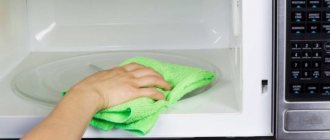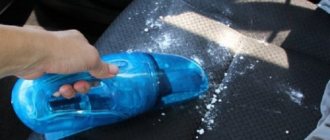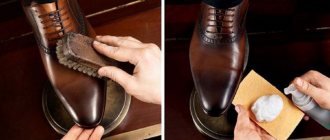Today, numerous interior items are one of the main attributes of a comfortable existence. But not every housewife knows how to get rid of the smell of new furniture that permeates the entire apartment.
Each item purchased requires special treatment. For example, if the set is made of chipboard or wood, you will feel not only natural aromas, but also mixed fumes from glue, as well as the consequences of transportation and previous storage. New furniture, be it a sofa or an armchair, has a specific smell, since the base and finishing materials are impregnated with chemicals used in production.
Such a background “smell” can bother you for up to several months. If you still haven’t decided what to do about it, our advice to you is to find its root cause! Try using the instructions below, they do not require special skills and will fix the problem fairly quickly.
Features of odor removal from furniture of various materials
After purchasing and unpacking interior items, an item made of any material may begin to smell. Following all the recommendations and conditions will get rid of the stench forever.
A specific heavy odor from chipboard is felt due to painting or varnishing of the material. They use substances that absorb odor. They are always at hand, they are universal helpers - salt, tea bags, citrus peels. We lay it out for several days in closets, bedside tables, wherever there is an unpleasant odor. Keep cabinet doors open. Then we ventilate the room. We remove absorbents, wipe the surfaces with vinegar solution, moistening them.
Leather
Not everyone loves the smell of new upholstered or leather furniture. The lucky owners will have to be patient. When chemically treating the material, leatherette or leather, the smell remains for a long time. The characteristic aroma is removed by ventilation; it is recommended to unfold the sofas. Place absorbent substances around: salt, tea bags, coffee beans. The use of standard methods is unacceptable, as is the use of special means, which can damage the leather upholstery.
Textile
A repulsive odor may come from fabric upholstery. The nature of the occurrence of unpleasant odors is different. A musty smell in new furniture can occur as a result of improper storage in a warehouse or humidity. You can get rid of it by keeping it in a draft for a day and ventilating it well. Close the windows and warm the air for about three hours at medium temperature. Do not heat the air too much; the parts may dry out. It is forbidden to dry furniture in direct sunlight, as the upholstery will fade.
If the source of the disgusting odor has penetrated deep into the upholstery, you should dry clean it or return it to the store under warranty.
If you can get rid of the cloying smell of new furniture in a couple of days, then the old one will only be absorbed more strongly. You will have to tinker to get rid of the unpleasant smell of dirt from old furniture. The cause may be spilled liquid, pets, small children. It is recommended to clean the surface with a vinegar solution or a product that absorbs car odors. Apply generously to the fabric and leave to dry. After the fabric has dried, put natural absorbents inside - salt, tea bags, coffee beans.
Ways to fight
If the aroma of new furniture is far from woody, do not despair. There are several ways to solve this problem: household chemicals and improvised means. Each of them has its own contraindications.
The speed of eliminating an unpleasant odor directly depends on the frequency of use of a particular method and the original source itself. Thus, leather upholstery can retain the smell for up to several months.
Fighting with specialized means
Purchasing industrial products and special equipment for purifying air from harmful and unpleasant odors is an expensive affair, but it allows you to eliminate the chemical odor of new furniture much faster.
Such methods are suitable for people sensitive to odors, or for rooms where quick results are needed (for example, children's rooms).
Furniture edge
Furniture that emits an unpleasant odor probably has poorly processed or untreated ends. This problem can be solved by purchasing furniture edges and gluing the ends.
Ozonizer
To remove unpleasant odors from new furniture, you can use a special device that works on the principle of an air filter - an ozonizer.
By passing the air in the room through itself, the device filters out harmful substances. But buying an ozonizer is an expensive pleasure, unjustified in most cases.
Liquid for removing unpleasant odors
A liquid product for eliminating odors from new furniture is very effective. It is sold in almost all household chemical stores. Designed for use on objects made of chipboard, plastic and wood.
The product is diluted and applied to the surface of the furniture, setting in the form of a thin film that does not allow the smell to spread. Manufacturers do not recommend using the chemical liquid for allergy sufferers.
Available means
Almost every apartment has salt, tea and activated carbon, and lemons and oranges are much more affordable than buying specialized equipment. Conventional home remedies are just as good as store-bought ones in removing unpleasant odors.
The greatest efficiency is achieved by using several methods simultaneously.
Drying and airing
The first and most correct decision is to try to ventilate the room in the apartment where the new furniture is located. It is necessary to pull out all the drawers and open the doors of cabinets, tables and bedside tables, and spread out the upholstered furniture as much as possible. It is worth remembering that formaldehyde is a toxic substance, so being in the same room with such products should be minimized for a while.
There are times when furniture smells musty, which indicates a violation of the conditions of its storage in the warehouse. In this case, a heater is placed in the room for 3-4 hours, turned on at medium power. But you should not place the heating device very close to the products to prevent them from drying out. It is also recommended to move upholstered furniture away from direct sunlight, as the upholstery may be damaged.
Absorbents
These are absorbent substances that absorb unpleasant odors or moisture. This category includes the following:
- Salt and tea. Bags of salt and tea bags placed in all drawers and cabinet shelves for several days, combined with constant ventilation, will help get rid of the smell of new furniture much faster.
- Activated carbon or ordinary charcoal. Paper or fabric bags of coal are placed inside cabinets, linen drawers and on shelves. In addition to unpleasant odors, it also absorbs excess moisture.
To achieve the best effect, it is recommended to change the bags with sorbents from time to time.
Essential oils
Open vials with essential oils or rags soaked in them placed inside the products will not eliminate the original source of the unpleasant odor in cabinets and on sofas, but will help smooth it out a little.
Orange peels are excellent neutralizers for chemical fragrances in new furniture. Rubbing with slightly diluted lemon juice will not only get rid of the unpleasant odor, but will also please citrus lovers.
Ammonia and vinegar
Ammonia is most often used to eliminate the unpleasant odor of leather upholstery of chairs, sofas and ottomans. For the solution that will need to be used to wipe the leather product, you will need:
- glass of water - 250 ml;
- a teaspoon of ammonia;
- Additionally, you can use vinegar or lemon juice in small quantities.
Use the solution with caution, first applying it to an inconspicuous area to test the reaction. If the color and structure of the upholstery material has not changed, the solution is applied to the entire surface
Rules of care
To prevent the sofa from becoming a source of unpleasant odors, it is necessary to maintain hygiene:
- Treat upholstery for stains immediately as soon as they are discovered.
- Constantly ventilate the room and monitor the humidity level.
- Remove sources of mold on the walls if they suddenly appear.
- Protect the sofa with covers if there are pets in the room.
If the sofa is in the living room combined with the kitchen, it is necessary to install a good hood in the kitchen, because otherwise the smell of cooked dishes will be perfectly absorbed into all textiles and upholstered furniture.
Advice! Sometimes it is necessary to ozonate furniture. After this procedure, the air in the room becomes fresh, as does the upholstery.
The sofa requires constant and careful care. Every month you need to knock out dust from it and clean it with a soapy mixture. If the sofa gets dirty, you need to immediately clean the area using available means.
It is advisable to keep pets away from the sofa. Animals must be aware that this is an unauthorized place for them.
Useful tips
There are many ways to neutralize persistent unpleasant furniture aroma. Each has its own pros and cons. The required efficiency can be achieved only if the following conditions are met:
- It's always worth focusing on your budget. If funds allow, it is better to immediately buy an ozonizer. During operation, it saturates the air with gas, which has disinfecting and deodorizing properties. It has a detrimental effect on pathogenic bacteria, viruses, fungi, and single-celled parasites. It will help fix the problem described in just a couple of hours. Anyone looking for less expensive methods can immediately try folk remedies.
- You should always try to find the cause of a persistent odor. If it is low-quality plastic or chipboard, it is better to immediately refuse the purchase and take the furniture outside. Such measures will be associated with large expenses and losses, but preserving your own health (and sometimes life) is worth it. Experts recommend discussing return conditions with sellers in advance. When this is not possible, you will have to order an independent examination at your own expense to determine whether the chipboard meets the standards. Results in favor of the consumer should force the seller to return the money.
- When using household chemicals, you must be extremely careful. Wrong actions can add a new aroma to an existing smell. Then dealing with them on your own will be extremely problematic.
Professional products
It is not necessary to spend money on an ozonizer or other special devices. You can use popular advice.
Essential oils
Peppermint and vanilla oils applied to a cotton pad are an excellent natural means of absorbing the strong aroma of furniture. Place unique sachets in cabinets and drawers.
Natural coffee beans are used, placed in small containers. Don't throw away coffee grounds. After diluting it a little with water, we place it in containers inside the furniture.
Charcoal
Bulb onions
Cut the onions lengthwise and place on plates. It will quickly absorb the smell of varnish and paint, and the residual natural onion scent will disappear quickly.
Lemon is considered a natural neutralizer. Cut it into slices and place it on the inner sections of the cabinets.
Pour distilled vinegar into a bowl and carefully place it in the required places.
If after all the manipulations you cannot get rid of the unpleasant fragrance, you should:
- contact professionals, a cleaning company;
- refuse to use an unsafe item for the sake of health.
Article verified
by the editors
Professional tools are not always at hand. The advantage of traditional methods is accessibility - there is always something in the house to remove unpleasant odors from upholstered furniture. It is recommended to carry out treatment immediately after contact with the odorous liquid.
- Soda. The product can be used for upholstery of any color, suitable for dampness and animal urine.
- Salt. The grains must be scattered over the upholstery, left for half a day, and removed with a vacuum cleaner. Suitable for treating a new sofa from the smell of glue, varnish, and chemicals.
- Laundry soap is used to clean a leather sofa from unpleasant odors, and to treat stains of urine, beer, and vomit.
- Vinegar. Used in solutions of different concentrations. After use, it is necessary to ventilate the room. For light-colored furniture, it is recommended to replace it with a solution of citric acid.
- Alcohol and hydrogen peroxide are useful for removing urine stains, vomit, and mold odors.
- Potassium permanganate. Will help when processing damp furniture.
For cleaning leather and leatherette
Effective against most odors
For upholstery of any color
From the smell of mold
From dampness
From the smell of a new sofa
Before starting work, it is necessary to prepare the surface. It is advisable to vacuum the upholstery and wipe with a damp cloth. The procedure will help avoid the appearance of mud stains. With the help of ready-made compounds, you can eliminate the smell from the sofa in the shortest possible time. The most effective are:
- Vanish. Liquid product. A cap of the product is mixed with water in a ratio of 1:9. It is necessary to beat the mixture, apply, and leave to soak for 30-60 minutes. The surface is cleaned with a vacuum cleaner.
- Allergy free. Sold in aerosol form, it is used to neutralize bacteria and fungi. The contents are sprayed over the affected surface without washing.
- Magos Dream JSC. The concentration of the solution ranges from 1:5 to 1:20, suitable for odors of varying strengths. Does not cause irritation upon contact with skin, can be stored for 2 years.
Before removing the smell from the sofa using professional means, you need to study the precautions and use them exactly according to the instructions, only for the designated materials. If necessary, you need to use a mask and gloves while working.
First aid for victims
The most important thing is to call an ambulance immediately! A person’s life often depends on the time of her arrival.
- The victim needs to be provided with fresh air and rest. If inhalation poisoning occurs, the person should be removed/removed from this room.
- Give the victim clean, cool water to drink (if he is conscious and there are no signs of the substance getting inside). You cannot try to rinse the stomach on your own or induce vomiting: doctors will do this using special solutions.
- Rinse the affected area of skin with running cool water for 15-20 minutes, while the formaldehyde solution still gets on the skin.
- Ensure airway patency if the person is unconscious: place him on his back and turn his head to the side.
Special cases
Let's look at how to get rid of some characteristic odors that are unpleasant for the person himself and his environment.
Tobacco
The best way to get rid of tobacco smell on clothes is to smoke only outside the apartment, otherwise the smoke will gradually permeate all things. The following remedies will help free things from the spirit of tobacco.
Vacuum cleaner
The smell of tobacco accumulates on dust in clothes. Things are knocked out, covered with a damp cloth and vacuumed at high power.
Tip: It is useful to keep clothes near steam - hang things near a hot shower, over a basin of hot water, then dry them. The smell of tobacco also quickly disappears in the cold.
Coffee
The coffee beans are ground and placed in a fabric bag. The smelly items are loosely placed in plastic bags for several hours, with coffee sachets placed between them. Outerwear is dried near the radiator, on which a bowl of ground coffee is placed.
Citrus peels
The peels, packed in fabric bags, are placed directly with the items in the drum. The same bags are placed in clothing closets so that the smell of freshness permeates the clothes.
New things
If airing does not get rid of the smell of dyes or synthetic fabrics from new things, ammonia will help. Take 1-2 tablespoons of ammonia per liter of cold water and soak the new item for an hour, then wash it in the recommended mode.
Pets
Special sprays help get rid of the smell of cats, dogs, birds and other pets on clothes. A home remedy is to soak the item in a vinegar solution (2 tablespoons per liter of water).
Rotten aroma
The smell of rotten meat can be easily removed using citrus fruits. Squeeze lemon juice (dissolve citric acid) and add to water when washing, soaking or rinsing. Let us remind you that the product has a whitening effect.
Sweat
The smell of sweat ingrained into clothes sometimes remains even after washing in an automatic machine. Often the item cannot be washed, and the sweaty smell needs to be gotten rid of.
Oxygen stain removers
Oxygen bleaches dissolve all contaminants in fabrics, so they can also eliminate odors. Use only on items that can be bleached.
Laundry soap
72% laundry soap kills most bacteria and helps get rid of fatty particles. Rub soap onto dirty areas, leave for 5-10 minutes, wash the item and rinse well.
Dish soap or hair shampoo
Sweat contains fatty particles, so dishwashing detergents and shampoo dissolve them well. Contaminated areas are moistened, left for an hour, then washed.
Cold environment
If you don’t have time to tinker with clothes, you can take things out into the extreme cold or place them in the freezer for several hours. The smell of sweat will die along with the bacteria.
Vinegar essence
The essence is diluted to a concentration of 6-9% (table vinegar). Place it in a spray bottle and spray individual areas or the entire item. Allow to dry well and ventilate.
Fish
To remove fishy smell, soak clothes in solutions:
- laundry soap;
- vinegar;
- light - in bleach;
- shampoo, dish soap.
After washing, items are rinsed in cold water.
Traces of gasoline or diesel fuel are first removed with a stain remover. Then they fight the smell by soaking the clothes in a solution of ammonia, soda, lemon juice, laundry soap or hydrogen peroxide.
Common cleaning mistakes
Materials such as silk, velor, flock cannot be cleaned with home remedies - special compounds are needed for delicate coatings.
Important! Do not use cleaning agents without testing their effects on an area of the surface that is not visible to the eye.
The most difficult stains to remove are blood and wine stains. When treating such stains, many make the fatal mistake of spreading the stains over the surface of the upholstery with a damp cloth. After such procedures, contaminants are absorbed into the fabric even more strongly, and the stain is not only not removed, but becomes larger.
Have you ever had to clean blood and wine stains from your upholstery?
Not really
Why does new furniture smell?
Obviously, new furniture smells of “manufacturing.” This includes formaldehyde, which is part of the laminated chipboard coating, and glue fumes, and other chemicals that emit an unpleasant odor. It not only causes discomfort, but can also be hazardous to health. The cheaper the furniture, the more toxic substances are used in production and the greater the chance of poisoning.
For example, budget options for cabinet and upholstered furniture and waste from the woodworking industry are inseparable concepts. To create such furniture, various resins and pastes are used.
A favorite of many, chipboard is nothing more than wood shavings bonded with chemicals such as formaldehyde and phenol. The human olfactory organ may not even detect them, while other symptoms - headache, allergic reactions - will certainly give a “distress signal”.
Chips and open “corners” of furniture are the most dangerous; shavings and resin emit the most toxic odor.
Although high-quality materials (natural wood, leather) are less toxic and hazardous to health, they can also introduce their own smell into the house. It is not as obvious and unpleasant as furniture made from cheap materials, but over time it can cause allergies, asthma and discomfort in children and the elderly.
Varnish, which is often used to coat wooden furniture, also makes its contribution. It emits harmful substances that settle in the air and can also cause damage to the health of household members.
Brief description of the substance
Formaldehyde (methanal, formic aldehyde) is a colorless, toxic, highly soluble gas in water, polar solvents and alcohols with a pungent odor, hazard class 1. An aqueous, urea-stabilized solution of formaldehyde is used in the furniture and woodworking industries in the production of chipboard and other “plywood” materials. It is used in the manufacture of thermoset polymers and in industrial organic synthesis. Widely used in light industry, medicine, cosmetology, and agriculture. It is characterized by good antiseptic, bactericidal, tanning and preservative properties.
Standard levels of formaldehyde in the air:
- Maximum single maximum permissible concentration (MPC) of formaldehyde (Russia) - 0.05 mg/m³;
- The average daily MPC (Russia) is 0.01 mg/m³;
- MPC of substance in the air of residential premises (European countries): 120 μg/m3;
- Odor threshold: 0.07—0.2 mg/m3;
- Threshold of the reflex response of the animal body: 0.04-0.098 mg/m3;
- Threshold of irritant effects on the mucous membrane of the human visual organs: 0.012 mg/m3.
Why do new products smell?
The smells emanating from new furniture are not always unpleasant. But this does not mean that they are absolutely safe for the health of household members. Basically, furniture products, including upholstered furniture, are made from chipboard (chipboard). And chipboard is the main source of formaldehyde and phenol, toxic substances that pose a certain danger to humans. The most pungent aroma comes from the uncovered ends of furniture and chips where shavings and resin are exposed.
We recommend that you read
The varnish used to coat wooden furniture also emits odor and releases harmful substances into the air. The air in the apartment becomes polluted, and this negatively affects people’s well-being.
In the production of furniture, laminate, decorative tiles, and upholstery materials impregnated with special substances can also be used, which allow the furniture to maintain its impeccable appearance for a long time. This “chemical” not only smells, but can also cause allergic reactions, headaches, asthmatic attacks and other unhealthy reactions of the body. Children and the elderly are at risk.
To reduce the risk of possible poisoning to zero, you need to buy certified furniture that meets established standards and has passed quality control. If a chip or other damage is found, the purchase should be returned to the store.
Inpatient treatment of acute formaldehyde poisoning
As a rule, even at the scene of an incident, the first aid team carries out measures to prevent further complications and save a person’s life:
- Probe lavage of the gastric cavity with water or saline solution.
- Administration of hemostatic drugs when signs of bleeding from the gastrointestinal tract occur.
- Administration of painkillers for severe pain (often with a burn of the esophagus), drugs that stabilize vital signs: heartbeat, blood pressure, breathing.
- Placement of a dropper with solutions to reduce intoxication.
- Intubation and artificial respiration for laryngeal edema.
The victim is hospitalized in the intensive care unit or toxicology department, where he is diagnosed and treated as follows:
- administration of ammonium carbonate or 3% chloride - formaldehyde antidotes;
- hemodialysis (for kidney damage);
- surgical intervention in the presence of bleeding from the gastrointestinal tract;
- other infusion therapy in the required volume.
The prognosis largely depends on the timeliness of medical care. In any case, this is a life-threatening condition that requires serious hospital treatment. After poisoning, sensitivity to formaldehyde increases significantly, so a subsequent similar situation can become fatal!











